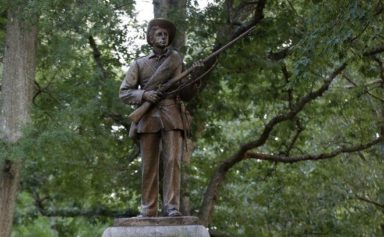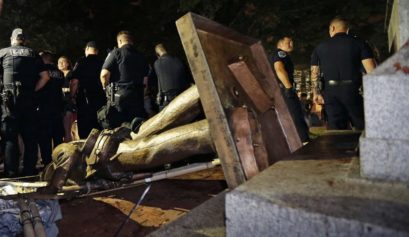Indigenous Australians Struggle To Tear Down Colonial Statues and Reclaim 65,000 Years of History. Although much attention has been paid to the many statues and monuments to the Confederacy in the United States, and the removal of these and other symbols of racial oppression, enslavement and genocide, America is not alone.
The Australian federal government wants to criminalize the defacing of statues, with a punishment of up to A$88,000 (US$70,566) and seven years imprisonment. This push by the government comes after a statue of Captain James Cook was defaced in Sydney’s Hyde Park. The statue contains a plaque declaring the explorer “DISCOVERED THIS TERRITORY 1770.” The monument of Cook was graffitied with the words “no pride in genocide” and “change the date.” The “date” refers to a movement to change the date of National Australia Day, the national holiday celebrating the arrival of the first British fleet to Australia on January 26, 1788, when the dispossession and theft of the Aboriginal people arguably began. A day of celebration for some is a day of mourning for others.
Statues of Queen Victoria and Lachlan Macquarie, the fifth governor of New South Wales, were also similarly spray-painted.
Calling the vandalism a “cowardly, criminal act,” Australian Prime Minister Malcolm Turnbull has compared the vandalism of the statues of Cook and Macquarie to “Stalinist purges,” and part of a “disturbing” campaign to obliterate the country’s history. Turnbull added that he knew as a child that Cook did not discover Australia, just as Marco Polo did not discover China and Columbus did not discover America, but that old histories should not be burned and old statues should not be torn down, but rather “challenged and complemented” by new ones.
Statues of James Cook, Lachlan Macquarie, and Queen Victoria has been vandalised in Hyde Park/Macquarie Street area. @7NewsSydney pic.twitter.com/G25tb0tX0Q
— Jason Morrison (@JasonMorrisonAU) August 25, 2017
#Cleaners get to work on #CaptainCook, #LachlanMacquarie & #QueenVictoria statues vandalised this morning. #HydePark pic.twitter.com/8k4nvpjRlo
— Paul Kadak (@PaulKadak) August 26, 2017
“This is what Stalin did. When he fell out with his henchmen he didn’t just execute them, they were removed from all official photographs — they became non-persons, banished not just from life’s mortal coil but from memory and history itself,” Turnbull said, offering that tearing down or defacing statues of colonial era leaders is much of the same. The Cook monument should be interpreted from the perspective of when they were erected in 1879. “How many ancient Roman monuments show slaves shackled to the chariot wheels of their Roman conquerors? Does that mean modern Italians endorse slavery? Or chariots?” he asked.
Turnbull’s Environment Minister Josh Frydenberg has moved to protect historic monuments, while opponents view this latest episode as part of the “culture wars,” and an attempt by politicians to appeal to far-right conservatives. The prime minister calls the vandalism of the statues an obliteration of history. The reality is these historical figures were responsible for the genocide and enslavement of Aboriginal people, while Americans are tearing down their monuments to hate, Australians remain oblivious to theirs.
Stan Grant, a prominent Aboriginal journalist, does not think these Australian statues are a part of protecting history and heritage, but one of forgetting a legacy of pain and suffering and a “violent rupture” of Aboriginal people that continues to the present day. “Across Australia there are monuments to those who drove Aboriginal people from their lands. There are reminders of frontier battles that are still not taught in our schools,” wrote Grant, who is indigenous affairs editor at the Australian Broadcasting Corporation (ABC). Grant added that no one present questioned that Cook founded the nation when his statue was erected. Today is different.
“My ancestors were here when Cook dropped anchor. We know now that the first peoples of this continent had been here for at least 65,000 years, for us the beginning of human time,” Grant said, adding the statue speaks to emptiness and the invisibility of Black people, “that nothing truly mattered, nothing truly counted until a white sailor first walked on these shores.”

The town of Gundagai, Australia has unveiled a statue honoring two Aboriginal men, Yarri and Jacky Jacky, who saved the lives of a third of the town in an 1852 flood. (Photograph: Michael McCormack, MP, Twitter)
As Black people in the United States take steps to reclaim history from racial revisionism and dismantle the symbols of the Confederacy and slavery, indigenous Australians seek to tear down the monuments and statues honoring colonial explorers, governors and monarchs. The debate does not take place in a vacuum, but rather comes on the heels of a May summit of Indigenous people calling for a treaty with the government and a representative body in parliament, and Black opposition to Australia Day, the national holiday which marks the arrival of the British fleet to Australia.
As is reflected in the struggle over the statues, indigenous Australians say they were “invaded” rather than discovered, victims of a mass murder that caused their numbers to dwindle from 1 million in 1788 to 0.1 million a century later, with 90 percent of the population exterminated by 1911. Between 1804 and 1834, 90 percent of the Tasmanian population was eliminated, dwindling from 5,000 to 200 in only three decades. The genocide continued with a social engineering measure in which 50,000 to 100,000 Aboriginal children were stolen from their families between 1910 and the 1970s, placed in schools where they were separated from their culture, forbidden to use their native language and were subjected to sexual abuse and exploitation. Aboriginal Australians continue to suffer from systemic racial discrimination and disparities in health, education and socioeconomic opportunity, and are disparately impacted by the criminal justice system.


